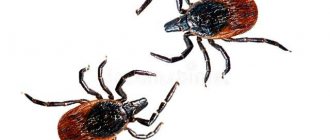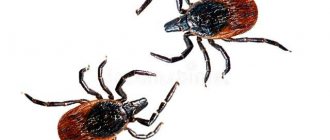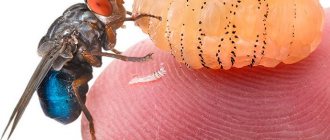- Egg. The female lays many eggs at once, there can be several thousand of them. Development at this stage lasts about 3 weeks. Fewer larvae appear than eggs were laid - not all individuals survive.
- Larva. Appears from an egg, the size of the larvae is up to 1 mm. It immediately begins to feed, when it is full, it disappears from the owner. In this phase, development lasts 1–6 weeks. After molting, it moves on to the next stage.
- Nymph. A fourth pair of legs appears and the body size increases. At this stage, the parasite is very similar to an adult tick, and the closer it is to the adult stage, the less differences there are between a nymph and a mature tick. The nymph develops in about a month; depending on external conditions, this period may slightly increase or decrease.
- Imago. Adult sexually mature individual.
The life cycle of a dog tick lasts 1–3 years. In the nymph and adult stages, the parasites overwinter normally and withstand cold weather in regions with a temperate climate. As soon as it gets warmer, bloodsuckers emerge from their winter shelters and begin to look for victims to feed on.
Habitat
The parasite is found almost everywhere - in central Russia and the southern part of Eurasia, in the northern regions of Africa and North America. The main condition for the survival of a tick in a certain area is the presence of a food source and humidity; without moisture, the parasites simply die (that’s why they love places closer to the ground, where there is a lot of vegetation and humidity). Dog ticks love warm microclimates and damp places, and are often found near rivers, in lowlands, forests and forest-steppe. If there is little food, parasites can live in dry and cool areas, but then they take longer to develop. If the winter is moderately cold, parasites can spread to northern regions.
Their main habitat is grass. They can climb onto shrubs along branches, but not higher than 0.5 m. The peak activity of dog ticks is spring and early summer. At the height of the seasonal heat (July - August), ticks prefer to hide in the shade - that is, exactly where we want to hide.
What does it eat?
Dog ticks feed on the blood of warm-blooded creatures. They can smell a potential victim at a distance of 10–20 meters - the parasites sense the warmth of a living creature thanks to thermoreceptors and react to the smell. The good news is that dog ticks cannot jump or fly; to attack, they need to be almost close to the victim - for example, when the victim passes next to a blade of grass on which the pest is sitting.
Clinging to the new “host”, the tick begins to search for a suitable place to bite. The pest prefers areas with delicate skin; it can often be found in the neck, head, ears, and groin area. Having chosen a place, the tick bites the skin and releases saliva with an anesthetic - thanks to this, the bite is not felt immediately, and the bloodsucker calmly drinks the blood. Males usually eat within 20–30 minutes, females need more time - they can feed for a day or even more. When the tick has eaten enough, it falls away from the “host’s” body on its own, and a red spot with a drop of dried blood remains at the site of the bite.
How does scabies appear in cats?
Invasive scabies infection in the cat family is fundamentally different from the human disease caused by a parasitic mite. An accurate diagnosis can only be made by a veterinarian based on a visual examination of the animal and the results of skin scraping analysis. The specialist will determine the type of scabies parasite, explain safety measures for the owner and prescribe treatment for the pet. There are three types of ticks in cats:
- Cheyletiellosis (scientific name Cheyletiella) - can be transmitted to humans, lives on the entire surface of the animal’s body.
- Notoedres - starts in the head area, provokes the formation of purulent crusts and hair loss. Can be transmitted to humans.
- Red-bodied tick (Trombicula) - chooses to live on the hind limbs of the body of cats, and can also be transmitted to humans.
In the initial stage, scabies appears in the neck, head and ears of the pet. Over time, the parasites spread over the entire surface of the animal’s body and lay eggs. In this regard, the aching itch worries the pet more and more, scratches and wounds appear on the skin, and the hair in these places falls out. In cats, scabies is accompanied by the following symptoms:
- increased anxiety and nervousness;
- refusal of usual food and water;
- aggressive behavior for no apparent reason;
- severe itching and increased scratching;
- hair loss;
- the appearance of purulent scratches on the surface of the skin.
If timely assistance is not provided, the disease progresses and the animal’s general condition becomes noticeably worse. Individuals with reduced immunity who have undergone a serious illness or surgery are at greater risk. In such cases, scabies may appear again and be more severe.
Dog tick: photo
The dog tick is an arachnid and in its structure, appearance and movements one can indeed find many similarities with spiders.
- The size of a hungry tick varies between 2–4 millimeters; females are usually larger than males.
- The color of the back is brown, with a brown or almost black circle halfway across the body from the head and below.
- The body of the tick is flat, together with its head it has a teardrop shape.
- The tick has 4 pairs of long legs.
- Well-fed ticks increase in size to 1–1.2 centimeters in diameter.
- The torso turns gray due to stretching of the tissues and blood inside the parasite.
- Once engorged with blood, the tick becomes round and shaped like a shiny bean with short legs sticking out in front.
Fortunately, dog ticks do not move as quickly as some types of spiders, so if you notice an insect on yourself or your pet that resembles a tick in shape, you can simply brush it off before the parasite finds a place to attach itself. If you doubt that you are faced with this particular species, look at what a dog tick looks like in the photo and, additionally using the description given above, try to more accurately identify the pest.
Diagnosis and treatment
To accurately determine the type of tick, a specialist must scrape it and send it for analysis. This is done in order to exclude diseases with similar symptoms - eczema, allergies, dermatitis or lichen. Drug therapy for a four-legged patient lasts on average from one to three weeks. Special shampoos, sprays, ointments, as well as oral medications of various forms (drops, syrups, tablets) are used as treatment. The approximate treatment formula looks like this:
- treating the affected surface with a gentle antiseptic - hydrogen peroxide, miramistin, chlorhexidine;
- taking antibiotics to prevent the risk of developing a secondary infection;
- use of acaricides to control insects;
- taking antihistamines to relieve itching;
- stimulating the work of immune cells with the help of vitamin complexes.
Particular attention should be paid to antiparasitic treatment. The dosage and drug should be determined by the doctor, taking into account the health characteristics of a particular animal. The effectiveness of the prescribed therapy will depend on the accuracy of the procedures recommended by the specialist. Even skipping a medication once will delay the healing process indefinitely.
When to take your dog or cat to the vet
If you did not do this immediately after the bite, then carefully monitor the animal’s well-being for at least three weeks. Signs of infection do not always appear immediately. Sometimes this happens after 7–21 days.
The first symptom of Preventing ticks on your pets is loss of appetite.
Here are a few more common signs of Tick-Borne Diseases in Dogs, in which you need to urgently rush to the clinic:
- weight loss;
- change in gum color;
- discharge from the eyes or nose;
- vomit;
- back or neck very sensitive to touch;
- convulsions;
- diarrhea;
- uncontrolled urination;
- brick-colored urine;
- swollen lymph nodes;
- swelling of the limbs or joints;
- weakness.
How is scabies transmitted to humans?
For infection from a sick animal, ordinary contact is sufficient. For example, a child who pets a stray animal on the street becomes a carrier of scabies mites. Infection can also occur if a free-ranging pet brings parasites home. However, not all types of cat scabies are dangerous to humans, among them:
- Hair mites are able to survive exclusively in animal fur; human skin is not suitable for their life and reproduction.
- Parasites that can live on the human body for no more than two days - in this way, insects only move long distances and, not finding a more suitable host, die.
- Small mites that appear during the period when the cat’s immune system is weakened are relatively harmless to a healthy person.
In medical circles, there is a special term that characterizes infection from a cat to a person - “pseudo scabies.” The fact is that ticks that carry invasive diseases can only comfortably exist on a cat’s body. Parasites can only stay on human skin for a short time, causing discomfort. Despite their apparent harmlessness, scabies mites can cause a lot of trouble, for example:
- feeling of discomfort;
- dryness and severe peeling of the skin;
- pimples and ulcers;
- cortical formations.
Pseudo scabies is not transmitted between people and goes away on its own, without medical intervention. If the above symptoms cause severe concern, you should consult a dermatologist.
Why is a forest tick bite dangerous for humans?
Tick bites are dangerous due to infection and pain. In addition to the discomfort of having a foreign body inside, the bite can be very painful. If you do not touch the tick, it will dig into the body as deeply as possible and it will be difficult to get it out. However, you should also not try to pull out the insect using “homemade” methods (using vegetable oil or alcohol). The best option would be to contact a specialist, because using the wrong methods can aggravate the situation and even cause additional harm to the skin.
Can a cat get infected from a person?
If a person can become infected with scabies from a four-legged friend, then the question is quite logical: does the opposite happen? The “human” scabies mite is physically incapable of surviving on the body of any animal, be it a cat, dog or hamster. However, pets can act as a means of transport or temporary shelter for such parasites. Thus, if an animal has been in contact with an infected person, then there is a risk of infection of its owner.
Antiparasitic treatment of fur and paws reduces the risk of your pet becoming a carrier of an unpleasant disease. There are a wide variety of sprays, drops and collars that protect against any pests. Before each walk, treat the surface of your cat’s body with a special product, and also regularly visit your veterinarian for a checkup.
Ixodid ticks - what are they?
Ixodid ticks are the most common group among these insects; they live on all continents of the world except Antarctica.
In appearance, ixodid ticks have an elongated body structure slightly narrowed towards the front; after feeding, the shape changes to spherical. The cuticle of the body is thin, but in some places it is compacted and forms scutes - in females only the front part of the body is covered with scutes, while males are covered with a dense cover over the entire back.
An adult has 6 pairs of legs, each with 2 claws and a sucker. In the front of the body there is a movable proboscis, and at the back there are breathing holes.
Preventive methods of controlling parasites
It is better to prevent any disease than to treat it, but it is impossible to isolate yourself from the whole world. Even if your pussy sits at home, you can infect it by bringing mites on your clothes or the soles of your shoes. Compliance with preventive measures includes:
- Minimizing contact with stray animals;
- Balanced nutrition for the pet - dry food should be at least premium, and homemade food only from high-quality products;
- Regular examination of the animal's fur and skin - first of all, the groin area, ears, armpits;
- Maintaining hygiene - cleaning bowls, toys and beds.
- Cat breeders should not separate kittens from their mother for up to two months - along with milk, the offspring receive passive immunity, which protects the animal from pathogenic organisms.
It is advisable to sterilize pets who have recovered from the disease in order to avoid hormonal imbalances, complicated by relapses in the future. If a cat is carrying kittens and at the same time has contracted scabies, there is a possibility of giving birth to offspring with pathologies. Compliance with hygiene rules and basic prevention will reduce the risk of infection for your pet.
Danger to people and animals
Dog ticks can attack not only dogs, but also other warm-blooded animals, such as cats and squirrels, as well as birds that nest near the ground. The larvae primarily feed on the blood of small animals (mice), while the nymphs choose larger victims - cats and dogs, cattle, deer and foxes. Parasites can also attack people; they usually do this in the imago stage (adults).
The main danger of ticks is dangerous infections that can be contracted through a bite. The causative agents of diseases are contained in the saliva of infected ticks - when the parasite bites through the skin and begins to suck blood, dangerous microorganisms enter the victim’s body along with its saliva.
A dog tick can infect a dog:
- borreliosis;
- piroplasmosis;
- ehrlichiosis;
- anaplasmosis.
Dog ticks are dangerous to humans, as they can infect diseases such as:
- borreliosis;
- tularemia;
- tick-borne encephalitis;
- monocytic ehrlichiosis;
- relapsing tick-borne typhus;
- Tsutsugumashi fever.
This is an incomplete list of diseases that dog ticks carry; we have listed only the most common ones. In addition to infections, potential risks after a tick bite include a severe allergic reaction, including respiratory failure and anaphylactic shock. After removing a tick (especially an incorrect one), inflammation and a purulent process may develop in the tissues.
Diseases of dogs and cats after a tick bite
What exactly is the threat of a tick bite to a cat or dog? Among the main diseases, the following are distinguished:
Encephalitis (a viral disease leading to inflammation of the meninges) - 6% of ticks are carriers.
Borreliosis (Lyme disease) is a bacterial disease that, without timely treatment, leads to disability and death.
Article continues after advertisement
Piroplasmosis (babesiosis) is an infection with protozoa that destroy red blood cells, which often leads to death.
Means for protection and prevention
To protect and prevent pets from dog ticks, most owners and veterinarians recommend using special insecticidal preparations:
- Drops on the withers. They are used to process animals with coats of different lengths. The amount of the drug is calculated taking into account the weight of the dog. The duration of action of the medicine is up to one month.
- Sprays are used to prevent tick infestation of smooth-haired dogs and young animals. The drug prevents ticks from attaching to animal fur. During treatment, the medicine is applied to the entire surface of the body, avoiding contact with the nose and eyes. Particular attention should be paid to the area behind the ears.
- Dry mixtures or powders. Powder preparations provide protection for animals against ticks for quite a long time. The compositions include the active ingredient pyrethroid. Drugs are often used to combat existing parasites. To do this, rub the product into dry hair, avoiding contact with eyes and mucous membranes.
- Bathing solutions. The products are added to the water during bathing and applied to wet hair. They effectively repel ticks. The validity period is one month.
- Collars are a strip of material impregnated with a special solution. Typically, a dog flea and tick collar does not kill parasites, but rather masks the dog's odor and makes it impossible to detect. To ensure protection, the dog must wear such a collar continuously for 5-6 months.
Reference. Medicines have a cumulative effect, that is, they tend to accumulate in the hair follicles. To ensure that the insecticide retains its effect, it is not recommended to wash the dog before and after treatment for three days.
The dog tick is a carrier of dangerous diseases that is widespread throughout the world. To avoid infection, during the period of ixodid activity, precautions should be taken and special means should be used.











